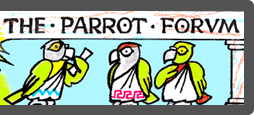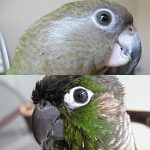I have been doing some reading on UVB light and wish to put one on his cage. I was just wondering what spectrum is best (I know every company has their own guidelines). I am thinking of using a 2.0 broad spectrum light (exo terra) [I also own reptiles, so know about how the wavelengths work physiologically]
Your help is greatly appreciated.
Any questions that will help you to help me, I will definitely answer



UVB Lighting
26 posts • Page 1 of 3 • 1, 2, 3
- lifesazoo33
- Lovebird
- Gender:

- Posts: 31
- Number of Birds Owned: 1
- Types of Birds Owned: Jardines Parrot
- Flight: No
Re: UVB Lighting
Lighting requirements for birds and reptiles are quite different. From what I understand if you use bulbs designed for reptiles it can potentially strain or damage a bird's eyesight. You don't want to use a UV-B light for your bird. Birds can see into the near UV-A spectrum but not the UV-B spectrum.
For a bird what you want is a full spectrum light that offers UV-A light and little or no UV-B. I use FeatherBrite bulbs which are Avian-specific but I'm sure there are other Avian-specific bulbs and/or other UV-A full spectrum bulbs that are appropriate. The bulb should have a CRI above 90 (CRI 100 is ideal) and a color temperature of 5,000 - 5,700K.
For a bird what you want is a full spectrum light that offers UV-A light and little or no UV-B. I use FeatherBrite bulbs which are Avian-specific but I'm sure there are other Avian-specific bulbs and/or other UV-A full spectrum bulbs that are appropriate. The bulb should have a CRI above 90 (CRI 100 is ideal) and a color temperature of 5,000 - 5,700K.
-

Andromeda - Poicephalus
- Gender:

- Posts: 438
- Location: Florida
- Number of Birds Owned: 2
- Types of Birds Owned: brown-headed parrot, green cheek conure
- Flight: Yes
Re: UVB Lighting
The bulb that I was thinking about purchasing has a CRI of 98. The colour temperature is 6700K.
How does the colour temperature affect parrots?
It is also a broad spectrum light, which provides UVA
How does the colour temperature affect parrots?
It is also a broad spectrum light, which provides UVA
- lifesazoo33
- Lovebird
- Gender:

- Posts: 31
- Number of Birds Owned: 1
- Types of Birds Owned: Jardines Parrot
- Flight: No
Re: UVB Lighting
The reason the color temperature matters for a bird is because you are trying to simulate sunlight, which is around 5,500K at noon. That's why you want a bulb with a color temperature of 5,000 - 5,700K. The higher you go on that scale, the bluer the light, so 6,700K is far too blue for a bird.
The most important thing to know is that for a bird you want to provide UV-A without the UV-B. If I'm looking at the right bulb (the one you mentioned in your first post) it contains 2% UV-B which is too high for a bird, and potentially harmful (too much UV-B light is associated with corneal burns and cataracts in birds).
The Exo-Terra lights are designed for reptiles and so their color temperatures and UV-B output are not appropriate for a bird, which is not a reptile. The FeatherBrite bulb, which is designed for birds, only contains 0.5% UV-B (4% UV-A) and its color temperature is 5,500K.
You don't have to go with FeatherBrite, but you do want to choose a bulb with a CRI of 90 - 100 and a color temperature of 5,000 - 5,700K. You also want a bulb that provides UV-A, with little or no UV-B.
Hopefully this helps.
The most important thing to know is that for a bird you want to provide UV-A without the UV-B. If I'm looking at the right bulb (the one you mentioned in your first post) it contains 2% UV-B which is too high for a bird, and potentially harmful (too much UV-B light is associated with corneal burns and cataracts in birds).
The Exo-Terra lights are designed for reptiles and so their color temperatures and UV-B output are not appropriate for a bird, which is not a reptile. The FeatherBrite bulb, which is designed for birds, only contains 0.5% UV-B (4% UV-A) and its color temperature is 5,500K.
You don't have to go with FeatherBrite, but you do want to choose a bulb with a CRI of 90 - 100 and a color temperature of 5,000 - 5,700K. You also want a bulb that provides UV-A, with little or no UV-B.
Hopefully this helps.
-

Andromeda - Poicephalus
- Gender:

- Posts: 438
- Location: Florida
- Number of Birds Owned: 2
- Types of Birds Owned: brown-headed parrot, green cheek conure
- Flight: Yes
Re: UVB Lighting
Very helpful. Thank you. I find that it is very hard to find a reliable source that gives you specifics as to what kind of lighting that birds need. Thanks for all of your knowledge 
- lifesazoo33
- Lovebird
- Gender:

- Posts: 31
- Number of Birds Owned: 1
- Types of Birds Owned: Jardines Parrot
- Flight: No
Re: UVB Lighting
lifesazoo33 wrote:Very helpful. Thank you. I find that it is very hard to find a reliable source that gives you specifics as to what kind of lighting that birds need. Thanks for all of your knowledge
Glad I could help.
What's troubling is that there are a couple of manufacturers out there who market their lights for birds but in reality it's just a re-packaged reptile bulb as evidenced by its high UV-B content which can potentially cause eye-sight issues in a bird.
Exposing birds to artificial UV-B lighting is somewhat controversial as you can find some studies that say completely avoid it and other studies that support it (in small amounts) for vitamin D3 synthesis. The reason why I use a FeatherBrite bulb is because it contains some UV-B but the amount is small (0.5%) so I'm not worried about it causing eye-sight issues.
Regardless of whether or not you have a full-spectrum bulb you should also take your bird outside (weather permitting) in a cage or on a harness to get some exposure to natural sunlight. 15 - 30 minutes total of direct sunlight per week is a good amount. If you live in a hot climate you should monitor the bird to make sure it's not getting over-heated (as evidenced by panting or holding the wings out away from the body).
-

Andromeda - Poicephalus
- Gender:

- Posts: 438
- Location: Florida
- Number of Birds Owned: 2
- Types of Birds Owned: brown-headed parrot, green cheek conure
- Flight: Yes
Re: UVB Lighting
This spring/summer will be our first one together, so he will be coming outside for a little bit (everyday is the plan). Since I live in the city and have seen hawks around, I am keeping him in a smaller cage with some mosquito netting (don't want him to get west nile). He loves looking outside so I think that he will have a blast!
What is the maximum amount of UVB that birds should recieve (that you have found in your research?)
Also, how can UVB be bad for them, when in the wild they would be exposed to it from the sunlight? (I don't know if you have come across this answer in the past)
Thank you again for your help. Fritz and I both appreciate it!
What is the maximum amount of UVB that birds should recieve (that you have found in your research?)
Also, how can UVB be bad for them, when in the wild they would be exposed to it from the sunlight? (I don't know if you have come across this answer in the past)
Thank you again for your help. Fritz and I both appreciate it!
- lifesazoo33
- Lovebird
- Gender:

- Posts: 31
- Number of Birds Owned: 1
- Types of Birds Owned: Jardines Parrot
- Flight: No
-

Michael - Macaw
- Gender:

- Posts: 6286
- Location: New York
- Number of Birds Owned: 3
- Types of Birds Owned: Senegal Parrot, Cape Parrot, Green-Winged Macaw
- Flight: Yes
Re: UVB Lighting
wow Micheal, you're so cryptic. 
If it looks like a duck, and quacks like a duck, we have at least to consider the possibility that we have a small aquatic bird of the family anatidae on our hands.
-Douglas Adams
-Douglas Adams
-

pionus - Poicephalus
- Gender:

- Posts: 309
- Location: Poulsbo, Washington
- Number of Birds Owned: 0
- Flight: Yes
Re: UVB Lighting
lifesazoo33 wrote:This spring/summer will be our first one together, so he will be coming outside for a little bit (everyday is the plan). Since I live in the city and have seen hawks around, I am keeping him in a smaller cage with some mosquito netting (don't want him to get west nile). He loves looking outside so I think that he will have a blast!
I'm sure he will enjoy time outside.
lifesazoo33 wrote:What is the maximum amount of UVB that birds should recieve (that you have found in your research?)
Also, how can UVB be bad for them, when in the wild they would be exposed to it from the sunlight? (I don't know if you have come across this answer in the past)
Birds are exposed to UV-B light in the wild but you have to remember that the atmosphere filters out the vast majority of UV-B light. How much UV light reaches the Earth depends on the season and where you are located, but just as a generic statement in the summer about 6% of light is UV-A while only 0.5% or less is UV-B.
You also have to consider that unlike a reptile that will bask in direct sunlight for hours, birds spend some of their time in trees or other vegetation where there is shade.
The reason why exposing birds to artificial UV-B light (as opposed to natural sunlight) is somewhat controversial is that there have only been a few studies on birds exposed to artificial UV-B light and those studies were on chickens and African greys. Since there's not a lot of research out there on parrots and artificial UV-B lighting there's not a set standard of how strong the UV-B should be, how long the bird should be exposed, how far the light should be from their cage, etc. but it is known that too much UV-B can cause corneal burns, cataracts, retinal burns, or sunburn to un-feathered areas.
Another thing to consider is that a bird is moving around, so its distance from the light varies. If you place the light over the top of the cage and the bird is at the bottom of the cage he might not be getting any of the UV light. However, if he stands at the top of the cage and basks in the light he might be getting too much.
This is why I ended up going with FeatherBrite, because their bulb is 0.5% UV-B which is close to what sunlight contains and offers some exposure without me having to worry that it's too much. As I said, though, there's not a solid standard on what is safe but the bulbs that offer 2%, 5%, or more contain more than they would be exposed to in the wild.
Whatever you choose be sure to monitor for signs of over-exposure. If you see your bird squinting, repeatedly rubbing its face against its body, or notice any redness around the eyes or on the skin then the exposure is too high.
The entire point of introducing artificial UV-B light is to allow the bird to synthesize vitamin D3 but keep in mind that if the bird is being fed a quality pellet such as Harrison's or Roudybush it is unlikely to be vitamin D3 or calcium deficient, anyway, because both of those pellets contain a vitamin D3 and calcium supplement.
The point of introducing an indoor source of UV-A is that a bird actually sees into the UV-A spectrum (they have four cones in their eyes as opposed to our three) and many birds have feathers that reflect UV light. Exposure to UV-A light indoors allows them to see colors that they would normally see in the wild but don't see in captivity where UV light is filtered out by windows. For example, here is what a budgie might look like to another budgie (in natural sunlight or artificial UV-A light):

However, since there is no UV-A light indoors unless you specifically provide it, it's kind of like a bird indoors is "color-blind"---it can still see red through violet but its forth cone that sees UV-A light is not being used.
-

Andromeda - Poicephalus
- Gender:

- Posts: 438
- Location: Florida
- Number of Birds Owned: 2
- Types of Birds Owned: brown-headed parrot, green cheek conure
- Flight: Yes
26 posts • Page 1 of 3 • 1, 2, 3
Return to Health, Nutrition & Diet
Who is online
Users browsing this forum: No registered users and 12 guests

